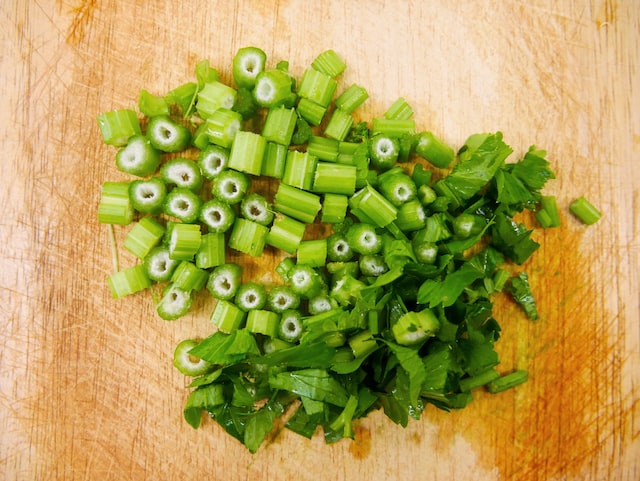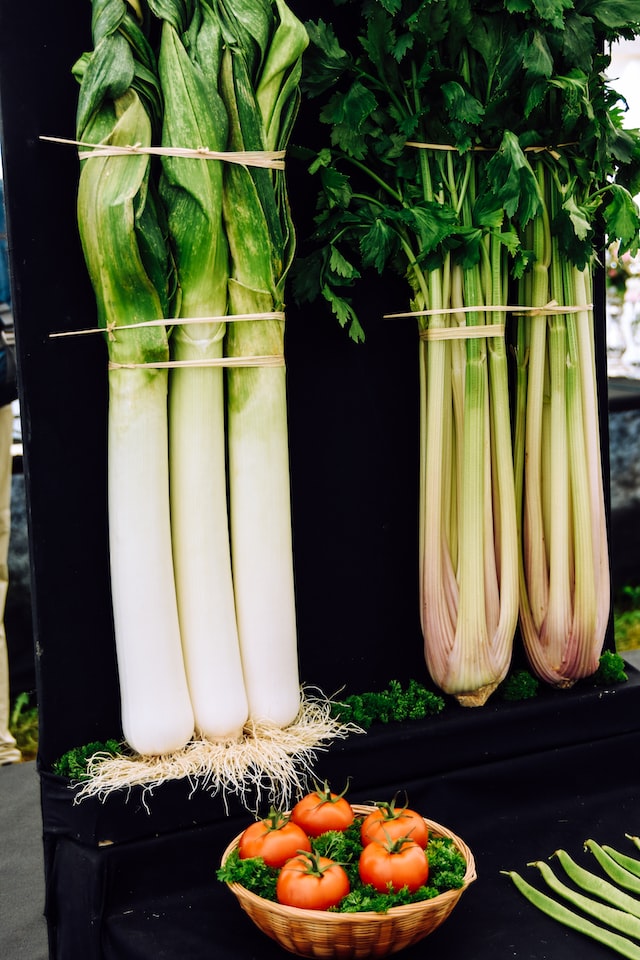Experience Freshness with Celery Cologne
Celery: A Versatile Green Wonder - From Perfumes to Fun Crazy Facts
Celery, known scientifically as Apium graveolens, is a humble and versatile vegetable that has found its way into various domains, including perfumes, fragrance, therapeutic oils, food, medicinal systems, history, and even fun crazy facts. This unassuming green wonder boasts a myriad of applications and intriguing characteristics that have fascinated people throughout history. In this article, we delve into the multifaceted allure of celery, exploring its diverse uses and the fascinating aspects that make it a true powerhouse.
1. Celery in Perfumes and Fragrance
While celery is not a common ingredient in mainstream perfumes, its unique aroma has inspired perfumers to create fragrances that capture its fresh, crisp, and slightly earthy scent. Celery seed oil, obtained from the seeds of the celery plant, is occasionally used in niche perfumery to add a green and vegetal aspect to fragrances. This unconventional note can lend an intriguing twist to fragrances and evoke a sense of nature and freshness.
2. Celery in Therapeutic Oils
Celery seed essential oil is renowned for its therapeutic properties. Rich in antioxidants and beneficial compounds, the oil is used in aromatherapy for its potential health benefits. It is believed to possess anti-inflammatory properties and may aid in relieving certain digestive discomforts. However, it is crucial to consult with a qualified aromatherapist or healthcare professional before using essential oils for therapeutic purposes.
3. Celery in Culinary Delights
Celery is a culinary staple used in various cuisines worldwide. Its crunchy texture and mild, refreshing flavor make it a popular addition to salads, soups, stews, and stir-fries. Additionally, celery's leaves and seeds are used as aromatic herbs to impart a delicate and distinct taste to dishes.
4. Celery in Medicinal Systems
Celery has a long history of use in traditional medicine for its potential health benefits. Ancient civilizations, such as the Chinese and Egyptians, recognized the medicinal properties of celery and used it to treat a range of ailments, including digestive issues and arthritis. Today, celery's reputation as a health-promoting food persists, and it is often included in diets for its nutritional value.
5. Historical Significance of Celery
The origins of celery can be traced back to ancient Mediterranean regions, where it was cultivated for both culinary and medicinal purposes. Celery holds cultural significance in ancient Greek and Roman mythology, where it was associated with deities and used in religious ceremonies.
6. Fun and Crazy Facts about Celery
a. Negative-Calorie Myth: Celery is often touted as a "negative-calorie" food, meaning it requires more energy to digest than it provides. While this is not entirely accurate, celery is still a low-calorie and nutrient-dense vegetable, making it a popular choice for weight-conscious individuals.
b. Popular in Bloody Mary: Celery is a classic garnish in the iconic cocktail, the Bloody Mary. Its crispness and mild flavor complement the spicy and tangy flavors of the drink.
c. Celery as a Toothbrush: Historically, celery was used as a natural toothbrush by chewing on its fibrous stalks to clean teeth and freshen breath.
d. Cultivation in Winter: Celery was originally grown as a winter vegetable in the Mediterranean due to its ability to thrive in cool temperatures.
e. Celery and the Moon: In certain folklore, celery is associated with the moon and believed to have lunar properties, making it an important ingredient in certain rituals and potions.
Celery, with its unassuming appearance and versatile applications, is a green wonder that has left an indelible mark in perfumes, therapeutic oils, food, medicinal systems, and beyond. From its potential health benefits to its historical significance, celery continues to captivate and inspire. Whether it's adding its distinctive aroma to niche fragrances or providing a delightful crunch to culinary dishes, celery's allure lies in its simplicity and adaptability. As we appreciate celery's contributions to various aspects of human life, it stands as a reminder of the extraordinary potential of ordinary plants and the wonders they offer.
Celery, known scientifically as Apium graveolens, is a humble and versatile vegetable that has found its way into various domains, including perfumes, fragrance, therapeutic oils, food, medicinal systems, history, and even fun crazy facts. This unassuming green wonder boasts a myriad of applications and intriguing characteristics that have fascinated people throughout history. In this article, we delve into the multifaceted allure of celery, exploring its diverse uses and the fascinating aspects that make it a true powerhouse.
1. Celery in Perfumes and Fragrance
While celery is not a common ingredient in mainstream perfumes, its unique aroma has inspired perfumers to create fragrances that capture its fresh, crisp, and slightly earthy scent. Celery seed oil, obtained from the seeds of the celery plant, is occasionally used in niche perfumery to add a green and vegetal aspect to fragrances. This unconventional note can lend an intriguing twist to fragrances and evoke a sense of nature and freshness.
2. Celery in Therapeutic Oils
Celery seed essential oil is renowned for its therapeutic properties. Rich in antioxidants and beneficial compounds, the oil is used in aromatherapy for its potential health benefits. It is believed to possess anti-inflammatory properties and may aid in relieving certain digestive discomforts. However, it is crucial to consult with a qualified aromatherapist or healthcare professional before using essential oils for therapeutic purposes.
3. Celery in Culinary Delights
Celery is a culinary staple used in various cuisines worldwide. Its crunchy texture and mild, refreshing flavor make it a popular addition to salads, soups, stews, and stir-fries. Additionally, celery's leaves and seeds are used as aromatic herbs to impart a delicate and distinct taste to dishes.
4. Celery in Medicinal Systems
Celery has a long history of use in traditional medicine for its potential health benefits. Ancient civilizations, such as the Chinese and Egyptians, recognized the medicinal properties of celery and used it to treat a range of ailments, including digestive issues and arthritis. Today, celery's reputation as a health-promoting food persists, and it is often included in diets for its nutritional value.
5. Historical Significance of Celery
The origins of celery can be traced back to ancient Mediterranean regions, where it was cultivated for both culinary and medicinal purposes. Celery holds cultural significance in ancient Greek and Roman mythology, where it was associated with deities and used in religious ceremonies.
6. Fun and Crazy Facts about Celery
a. Negative-Calorie Myth: Celery is often touted as a "negative-calorie" food, meaning it requires more energy to digest than it provides. While this is not entirely accurate, celery is still a low-calorie and nutrient-dense vegetable, making it a popular choice for weight-conscious individuals.
b. Popular in Bloody Mary: Celery is a classic garnish in the iconic cocktail, the Bloody Mary. Its crispness and mild flavor complement the spicy and tangy flavors of the drink.
c. Celery as a Toothbrush: Historically, celery was used as a natural toothbrush by chewing on its fibrous stalks to clean teeth and freshen breath.
d. Cultivation in Winter: Celery was originally grown as a winter vegetable in the Mediterranean due to its ability to thrive in cool temperatures.
e. Celery and the Moon: In certain folklore, celery is associated with the moon and believed to have lunar properties, making it an important ingredient in certain rituals and potions.
Celery, with its unassuming appearance and versatile applications, is a green wonder that has left an indelible mark in perfumes, therapeutic oils, food, medicinal systems, and beyond. From its potential health benefits to its historical significance, celery continues to captivate and inspire. Whether it's adding its distinctive aroma to niche fragrances or providing a delightful crunch to culinary dishes, celery's allure lies in its simplicity and adaptability. As we appreciate celery's contributions to various aspects of human life, it stands as a reminder of the extraordinary potential of ordinary plants and the wonders they offer.
To experience augmented reality, please open the Facebook-app using QR code and point to the image below
Celery is a vegetable that belongs to the Apiaceae family, which also includes carrots, parsley, and fennel. It is a long, thin, green stalk that is often used in cooking as a flavoring or as a vegetable. Celery can be eaten raw or cooked, and is often used in soups, stews, and salads. It is a good source of vitamins and minerals, and is low in calories.
Premium Energizing Fragrance for Men
Celery has been cultivated for thousands of years, with evidence of its use dating back to ancient Egypt. The ancient Greeks and Romans also used celery for medicinal purposes, and it was considered a symbol of strength and victory. Celery is believed to have originated in the Mediterranean region, and was first cultivated in Europe in the 16th century. In the 19th century, celery cultivation began in the United States, and it quickly became a popular vegetable crop. Today, celery is grown in many countries around the world, with China being the leading producer.
Discover the Power of Celery Seed Extract
Celery fun fact
- Celery is a low-calorie food, with only about 6 calories per stalk.
- Celery is composed of mostly water, making it a great food to help stay hydrated.
- Celery leaves are edible and can be used in soups, stews, and as a garnish.
- Celery contains a compound called apigenin which has anti-inflammatory properties.
- Celery is also a good source of Vitamin K, and folate.
- Celery is known for its "negative" calories, meaning that it takes more calories to digest celery than it provides.
- Celery is often used in dieting, due to its low calorie content.
- Celery also have a long history of being used as a traditional medicine.
- Celery seeds are used as a spice in many dishes and are also used to make a popular drink called Celery tonic.
- Celery can also be used as a natural remedy for conditions such as high blood pressure and water retention.
Embrace the Brightness of Celery Scent
Celery essential oil is derived from the seeds of the celery plant, and is known for its numerous health benefits. Some of the potential benefits of celery essential oil include:
- Reducing inflammation: Celery essential oil has anti-inflammatory properties that can help to reduce pain and swelling in the body.
- Lowering blood pressure: Celery essential oil may be able to help lower high blood pressure by relaxing the muscles in the blood vessels.
- Improving digestion: Celery essential oil can help to stimulate the production of bile, which can aid in the digestion of fats.
- Relieving anxiety and stress: Celery essential oil has a calming effect on the body, which can help to reduce feelings of anxiety and stress.
- Enhancing the immune system: Celery essential oil has been shown to help boost the immune system by stimulating the production of white blood cells.
Crafting the Perfect Men's Perfume
Celery is not a commonly used ingredient in perfumery, but it is known for its fresh and green scent. Celery is a part of the botanical family Apiaceae, which also includes other plants such as carrot and parsley. These plants are known for their fresh, green, and slightly spicy aromas and are sometimes used as a note in perfumes.
One famous perfume that features celery notes is "Eau de Celeri" by Etat Libre d'Orange. The scent is described as a "green and light scent" with notes of celery, green apple, and lemon. The composition of the perfume is built around the celery note and is intended to capture the freshness of a celery stalk.
Another perfume that features celery note is "Vetiver Celery" by Miller Harris. This fragrance features a unique combination of fresh celery and smoky vetiver, resulting in a fresh, herbaceous scent.
It's worth noting that the use of celery in perfumery is not common and perfumes featuring celery notes are not as popular as other perfumes with more common ingredients.
One famous perfume that features celery notes is "Eau de Celeri" by Etat Libre d'Orange. The scent is described as a "green and light scent" with notes of celery, green apple, and lemon. The composition of the perfume is built around the celery note and is intended to capture the freshness of a celery stalk.
Another perfume that features celery note is "Vetiver Celery" by Miller Harris. This fragrance features a unique combination of fresh celery and smoky vetiver, resulting in a fresh, herbaceous scent.
It's worth noting that the use of celery in perfumery is not common and perfumes featuring celery notes are not as popular as other perfumes with more common ingredients.
Join Scentopia, Sentosa's latest tourist attraction wonderful orchid scent crafting, fragrance tour, bridal shower or corporate team building which includes perfume making onsite and offsite, beach activities and more. We also serve primary school learning journey, secondary students and pupil on industrial excursions. Know more about our orchids perfume bar or therapeutic orchid scents and other wellness aromas. Conatct Perfume workshop or book a scent crafting session here.






